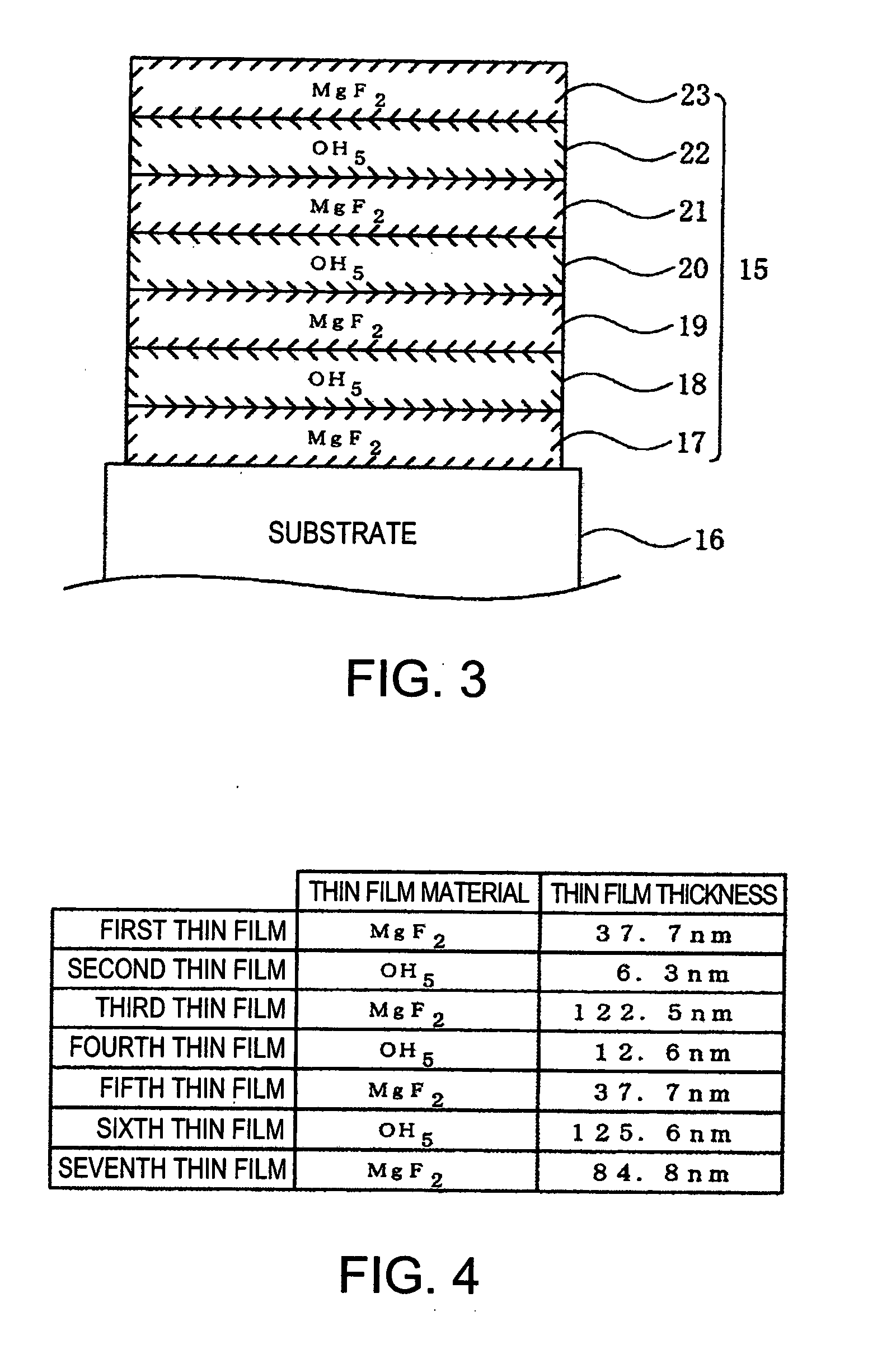Broadband antireflection coating
a broadband, anti-reflection technology, applied in the direction of optical elements, lighting and heating apparatuses, instruments, etc., can solve the problems of subtle color change and the like, the anti-reflection coating of related art had quite a few negative effects on the optical characteristics of the optical element, and the optical characteristics of the optical-related device changed, so as to reduce the variations in the transmittance characteristics broaden the bandwidth of the anti-reflection coating
- Summary
- Abstract
- Description
- Claims
- Application Information
AI Technical Summary
Benefits of technology
Problems solved by technology
Method used
Image
Examples
first embodiment
[0033] In the first embodiment, H4 ( a mixture of La and TiO2) which has a refractive index of approximately 2.00 is used as the high refractive index material for thin film, and MgF2 which has a refractive index of approximately 1.38 is used as the low refractive index material for thin film. With that, a material for the second thin film 9 is to be H4, a material for the third thin film 10 is to be MgF2, a material for the fourth thin film 11 is to be H4, a material for the fifth thin film 12 is to be MgF2, a material for the sixth thin film 13 is to be H4, and a material for the seventh thin film 14 is to be Mg F2.
[0034] Next, a calculation formula to obtain respective optimum thicknesses of seven thin film layers forming the broadband antireflection coating 6 is to be shown and the concrete values of the thickness is to be described.
[0035] When a physical film thickness of each layer is represented as dm (m=1, 2, 3, 4, 5, 6, and 7, indicating the position of layer of the thin f...
second embodiment
[0050] In the second embodiment, OH5 which has a refractive index of approximately 2.07 is used as the high refractive index material for thin film, and MgF2 which has a refractive index of approximately 1.38 is used as the low refractive index material for thin film. With that, a material for the second thin film 18 is to be OH5, a material for the third thin film 19 is to be MgF2, a material for the fourth thin film 20 is to be OH5, a material for the fifth thin film 21 is to be MgF2, a material for the sixth thin film 22 is to be OH5, and a material for the seventh thin film 23 is to be MgF2.
[0051] Next, a calculation formula to obtain respective thicknesses of seven thin film layers forming the broadband antireflection coating 15 is to be shown and the concrete values of the thickness is to be described.
[0052] As in a case of the first embodiment, when a physical film thickness of each layer is represented as dm (m=1, 2, 3, 4, 5, 6, and 7, indicating the position of layer of th...
PUM
| Property | Measurement | Unit |
|---|---|---|
| thickness | aaaaa | aaaaa |
| thickness | aaaaa | aaaaa |
| thickness | aaaaa | aaaaa |
Abstract
Description
Claims
Application Information
 Login to View More
Login to View More - R&D
- Intellectual Property
- Life Sciences
- Materials
- Tech Scout
- Unparalleled Data Quality
- Higher Quality Content
- 60% Fewer Hallucinations
Browse by: Latest US Patents, China's latest patents, Technical Efficacy Thesaurus, Application Domain, Technology Topic, Popular Technical Reports.
© 2025 PatSnap. All rights reserved.Legal|Privacy policy|Modern Slavery Act Transparency Statement|Sitemap|About US| Contact US: help@patsnap.com



